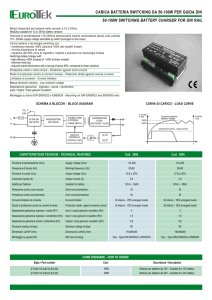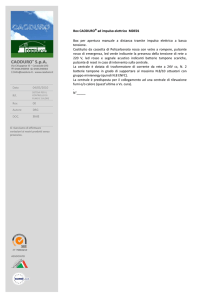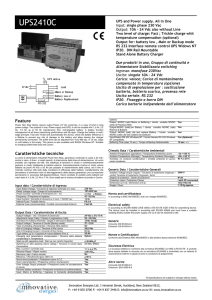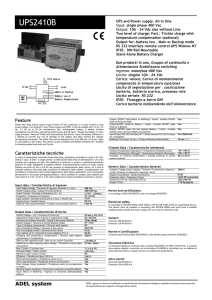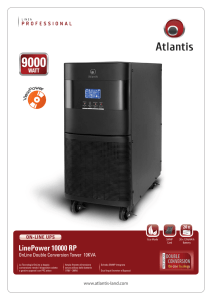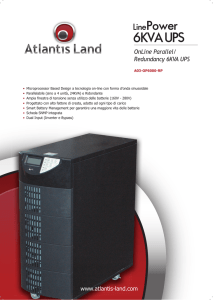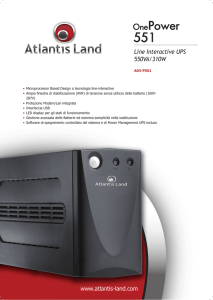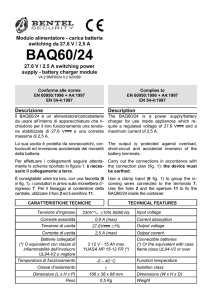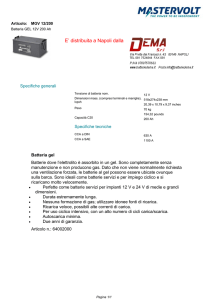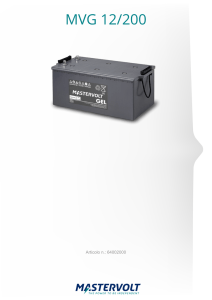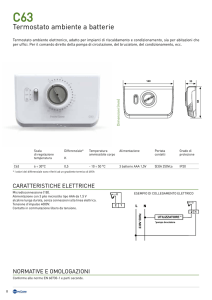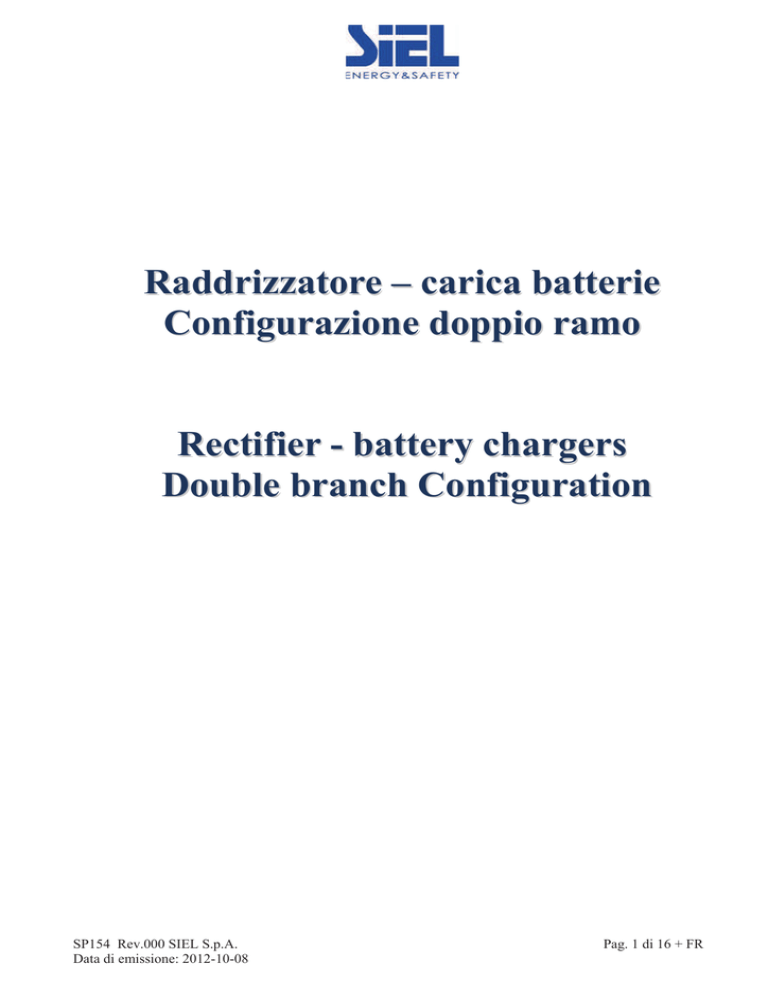
Raddrizzatore – carica batterie
Configurazione doppio ramo
Rectifier - battery chargers
Double branch Configuration
SP154 Rev.000 SIEL S.p.A.
Data di emissione: 2012-10-08
Pag. 1 di 16 + FR
Indice Index
Capitolo / Chapter
Argomento / Topic
Pag.
1
INTRODUZIONE – Introduction
1
PRINCIPIO DI FUNZIONAMENTO - Principle of operation
2
DATI GENERALI- Datasheet
5y6
3
CURVA DI RICARICA BATTERIE – Curve battery charge
6
3.1
Type IU DIN 41773
6
3.2
Type I1 I2 U
7
3.3
Type MANUAL
8
3.4
Test batterie e polo a terra –
Battery test and polarity earth
8y9
4
REQUISITI FUNZIONALI- Functional requirements
Raddrizzatore – Rectifier
3
3y4
9
9y10
5
STRUMENTAZIONE – Instruments
11y13
6
PORTA COMUNICAZIONE – Comunication port
13
7
ORGANI DI MANOVRA – Switches
13
8
ALLARMI REMOTI – Remote alarms
14
9
PROVE E COLLAUDI – Test
14
9.1
14
Prove di accettazione – Acceptance tests
10
NORME DI RIFERIMENTO – DESIGN STANDARDS
15
11
SCHEMA UNIFILARE – ONE LINE DIAGRAM
16
SP154 Rev.000 SIEL S.p.A.
Data di emissione: 2012-10-08
Pag. 2 di 16 + FR
1.
Introduzione - Introduction
La presente specifica tecnica si prefigge l’obbiettivo di descrivere le caratteristiche dei raddrizzatori stabilizzati
della serie Raddrizzatore SIEL in configurazione DOPPIO RAMO . Questi nuovi apparecchi sono il frutto di
una attenta azione di ricerca e sviluppo,svolta dalla nostra Società, mirata ad ottenere la massima affidabilità e
le migliori prestazioni nel campo dei sistemi di alimentazione di emergenza in corrente continua in modo
particolare per tutte le applicazioni di servizi ausiliari presenti nelle cabine di trasformazione. Non a caso si è
scelto di realizzare la sezione di conversione di energia in tecnologia tradizionale ( trasformatore d’isolamento
con ponte a tiristori) ,abbinandola alla flessibilità ed all’avanguardia di una logica digitale con micro controllore .
Il sistema è composto da due sezioni indipendenti definite rispettivamente RAMO SERVIZI ( RS ) e RAMO
CARICA BATTERIE ( RCB ). Tutte le informazioni riguardanti lo stato di funzionamento del sistema sono
disponibili su pannello operatore (Human Machine Interface) “touch screen” da 3,5” a colori completo
d’interfaccia seriale RS232 (Opzionale RS485 oppure ETHERNET TCP/IP) su protocollo MODBUS RTUSLAVE per il collegamento con PC Master .
This technical specification describes the characteristics of stabilized rectifiers in series configuration
Raddrizzatore SIEL
DOUBLE BRANCH. These new devices are the result of careful research and
development activities conducted by our company, aimed at achieving the highest reliability and best
performance in the field of systems for emergency power in DC in a special way for all applications for
services auxiliaries in the cabins of transformation. If you did not chose to implement the section of energy
conversion in traditional technology (isolating transformer with a thyristor bridge), combined with flexibility
and at the forefront of digital logic with a micro controller. The system consist of two independent sections
defined in SERVICE BRANCH (RS) and BATTERY CHARGER BRANCH (RCB).All information concerning
the status of the system are available on the operator panel (Human Machine Interface) "touch screen",3.5
inch. colors complete with serial interface RS232 (Optional RS485 or Ethernet TCP / IP) on a MODBUS
RTU SLAVE protocol for connection PC Master.
Principio di funzionamento - Principle of operation
In condizioni di funzionamento normale , le utenze sono alimentate attraverso il ramo RS mentre il ramo
RCB provvede alla ricarica del banco batterie seguendo il ciclo impostato. Alla mancanza di alimentazione
primaria , le utenze verranno alimentate dagli accumulatori attraverso il “blocco di commutazione“
composto da un diodo , posto su presa intermadia del banco batterie, e da un teleruttore di potenza posto
sul positivo generale degli accumulatori. Al ripristinarsi delle condizioni di normalità il sistema riprende il
suo funzionamento regolare , ovvero il ramo RS alimenta il carico mentre il ramo RCB ricarica gli
accumulatori. La condizione di guasto di uno dei due rami può essere gestita con due configurazioni
distinte ( da definirsi in fase di richiesta):
BASE : In caso di guasto del ramo RS , il ramo RCB può alimentare il carico alla tensione di mantenimento
( oppure ad una tensione definita di “EMERGENZA “ con aggiunta di apposita scheda opzionale cod.2R-3 ;
tale valore di tensione può essere < = > rispetto alla tensione di mantenimento nominale) e con il limite di
corrente stabilito in fase di richiesta. In caso di guasto del ramo RCB il ramo RS non potrà ricaricare le
batterie
AVANZATO : In caso di avaria di uno dei due rami , il restante sostituirà completamente quello guasto sia
come alimentazione delle utenze che come ricarica delle batterie. E’ importante sottolineare che entrambe
i rami dovranno avere la stessa potenza e le stesse caratteristiche. Con questo tipo di sistema a tutti gli
effetti si realizza una configurazione di “RIDONDANZA” al fine di aumentare l’affidabilità del sistema e di
garantire un elevato grado di sicurezza verso il carico. Il ramo che in fase di progetto verrà definito come
RCB potrà essere sempre completato con le opzione cod. 2R-2 , cod. 2R-3 , cod. 2R-4 per una ottimale
gestione del banco batterie
SP154 Rev.000 SIEL S.p.A.
Data di emissione: 2012-10-08
Pag. 3 di 16 + FR
In normal operation, the loads are fed through the RS branch while the branch RCB recharged the battery
pack by following the cycle set. In the absence of primary power, the utilities will be powered by batteries
through the "block switching" composed of a diode, taking place on the part of the battery pack, and a
power contactor placed on the overall positive accumulators. The restoration of normal conditions the
system resumes its normal operation, the RS branch supplying the load while the RBC branch recharge the
batteries. The condition of failure of one of the two branches can be operated with two distinct
configurations (to be determined on request):
BASE : A failure of the RS branch, the branch RCB can power the load voltage to maintain (or at a voltage
defined "emergency" with added special option card cod.2R-3 ; this voltage can be < = > compared to
nominal voltage maintenance ) and the current limit set at request. In case of failure of the branch RCB the
branch RS can not recharge batteries
ADVANCED: A failure in one of two branches, the remainder will replace completely the fault as power load
and recharging batteries. It's important to note that both branches will have the same power and the same
characteristics. With this type of system is in effect creates a configuration of "REDUNDANCY" for increase
system reliability and ensuring a high degree of safety to the load. The branch at the planning stage will be
defined as RCB will always be completed with the option code. 2R-2, code 2R-3, code 2R-4 for optimal
management of battery.
SP154 Rev.000 SIEL S.p.A.
Data di emissione: 2012-10-08
Pag. 4 di 16 + FR
2.
Dati generali – Datasheet
Tensione ingresso (Vac)
Input Voltage
Frequenza ingresso
Input frequency
Corrente c.c. ingresso
Input short circuit current
Distorsione corrente ingresso
Input current distortion
Fattore di potenza ingresso
Input power factor
Rendimento tipico di conversione
Typical conversion efficiency
Tensione nominale di uscita ( Vdc )
Output nominal voltage
Corrente di uscita ( Amp )
Output current
- Mantenimento Floating
For Battery Charge Branch
- Rapida Boost ( option )
For Battery Charge Branch
- Manuale Manual ( option )
- External potentiometer ( option )
For Battery Charge Branch
Stabilità tensione di uscita
Output voltage stability
Output ripple -RMS
Sovraccarico
Overload
Curva di ricarica batterie
Battery recharging system
Livello rumore
Acoustic nois level
EMI
Temperatura di esercizio ( °C )
Operating temperature
Temperatura di stoccaggio ( °C )
Storage temperature
Umidità relativa ( no condens.)
Relative humidity
Ventilazione
Ventilation
Altitudine ( mt. above see level)
Altitude
SP154 Rev.000 SIEL S.p.A.
Data di emissione: 2012-10-08
DATI ELETTRICI – ELECTRICAL DATA
230 +/- 10% 2 fili / wire
400 +/- 10% 2 fili / wire
400 +/- 10% 3 fili / wire
(depending on power - other on request)
50 y 60Hz +/-5%
d 15KA rms
d 40 ( 1Ph) d 27 ( 3Ph)
(at VAC nominal ,IEC standard)
t 0.70 ( 1Ph) t 0.80 ( 3Ph)
At nominal load ( THD%)
t 0.80 ( 1Ph) t 0.90 ( 3Ph)
(At nominal input voltage , 100% load)
24 y 48 y110 y 220
(At nominal input voltage , 100% load)
Valide per ramo RS e RCB
Valid for branch RS and RCB
10 y 250 *24VDC
10 y 250 *48VDC
10 y 200 *110VDC
10 y 100 *220VDC
2,27V/cell for VRLA battery type ( adjustable with trimmer)
2,2 y 2,3 V/cell for VLA battery type ( adjustable with trimmer)
1,4 y 1,5 V/cell for Ni-Cd battery type ( adjustable with trimmer)
2,4 y 2,45V/cell for VLA battery type ( adjustable with trimmer)
1,5 y 1,65 V/cell for Ni-Cd battery type ( adjustable with trimmer)
2,35V/cell for VRLA battery type ( adjustable with trimmer)
2,7 V/cell for VLA battery type ( adjustable with trimmer)
1,7 V/cell for Ni-Cd battery type ( adjustable with trimmer)
(Other on request)
1%
(At nominal input voltage , 100% load)
2% ( 1Ph) 1% ( 3Ph)
( other on request)
< 120% for 20 min . <150% for 1min. >150% for 10sec.
(without battery)
IU – DIN 41773 – standard – see PICTURE 2
I1 I2 U – option - see PICTURE 3
Manual – option
Thermal compensation – option
DATI AMBIENTALI – ENVIRONMENTAL DATA
<65
(according EN50091) - dB – with forced ventilation
EN 61000-6-2 EN 61000-6-4
-10….+40
-20….+70
<95%
Forced – Natural
( depending on power )
< 2000 ( de - rating according EN62040-3)
Pag. 5 di 16 + FR
Grado di protezione
Protection degree
Colore
Color
Dimensioni ( l*p*h) mm
Dimensions ( w*d*h) mm
Connessioni cavi IN/OUT
I/O cable connection
Trasporto
Trasport
Installazione
Installation
Accessibilità
Accessibility
3.
DATI MECCANICI – MECHANICAL DATA
IP31 ( ref.IEC 60529 )
(Other on request)
RAL 7035 – standard 600*600*1600 600*600*1940 800*800*1940
( depending on power )
Fronte - Front
Base per movimentazione con carrelli
Base provided for forklinft handling
Tenere 30 cm dai muri rispetto al tetto , lati e retro
Aria entra fronte / basso ed esce su lato retro
30 cm from roof , from lateral and from rear walls
Air incoming from the front / bottom . Air outlet from the rear .
Fronte , Alto , Retro
Front , High , Rear
CURVA DI RICARICA BATTERIE per Ramo RCB – Curve battery charge for RCB Branch
3.1: Curva di ricarica tipo IU in accordo con DIN41773 standard
Questa ricarica prevede due differenti fasi :
Fase 1: la corrente è costante e la tensione aumenta
Fase 2: la corrente diminuisce e la tensione è costante
Quando la corrente di ricarica và al di sotto di un determinato valore , la batterie viene considerata carica
ed il ciclo è finito .In questa situazione l’uscita si porta al valore di floating che risulta essere il valore
minimo necessario per il corretto mantenimento di ricarica dell’accumulatore.In OPZIONE
( cod. opzione 2R-3) può essere abbinato a questo livello di ricarica la “COMPENSAZIONE DI
TEMPERATURA “( coefficiente di compensazione di circa 0.03V/el/°c) sia con sonda interna ( nel caso di
batterie interne al raddrizzatore ) che esterna nel caso di accumulatori in armadio separato
( cod. opzione 2R-4)
Curve charging type UI in accordance with DIN41773 standard
This recharge contains two different phases:
Phase 1: the current is constant and the voltage increases
Phase 2: the current decreases and the voltage is constant
When the charging current goes below a certain value, the battery is considered charged and the cycle is
end. In this situation, the output is floating to the value of which is the minimum necessary for proper
maintenance charging accumulator. In OPTION (cod. option 2R- 3) can be combined with this level of
charging the 'COMPENSATION TEMPERATURE "( compensation factor about 0.03V/el/°c)both internal
probe (in case of battery internal rectifier) and external in the case of batteries separate cabinet (cod.
option 2R- 4)
SP154 Rev.000 SIEL S.p.A.
Data di emissione: 2012-10-08
Pag. 6 di 16 + FR
3.2: Curva di ricarica tipo I1 I2 U – OPZIONE ( cod. 2R - 3)
Questo tipo di ricarica è consigliato per batterie a vaso aperto e/o NiCd. Il sistema è completamente
automatico in quanto misura la corrente di ricarica richiesta dalle batterie.Se questa supera il valore di setpoint I2 , il sistema si porta automaticamente in “CARICA BOOST” ( il cui valore di tensione è regolabile
mediante trimmer) e vi rimane sino a che la corrente di ricarica non risulta inferiore al set-point I1 ; a questo
punto il sistema si riporta in “CARICA FLOATING” ( il cui valore di tensione è regolabile mediante
trimmer).La “CARICA BOOST” AUTOMATICA è protetta da timer di sicurezza interno ( tempo fisso di 12
ore ) che disattiva la funzione nel caso in cui nel tempo stabilito ( ovvero 12 ore ) la corrente richiesta dalle
batterie non sia divenuta inferiore a set-point I1.Questo tipo di curva di ricarica può essere inibito mediante
dip-switch presente su scheda di controllo.
Curve charging type I1 I2 U - OPTION (option code 2R - 3)
This type of charging batteries is recommended to vented and / or NiCd. The system is fully automated as
a measure of the charging current required by this batteries . If this exceeds the set-point value of I2, the
system is automatically " BOOST CHARGE" (the value of voltage is adjustable by trimmer) and remains
there until that the charging current is not less than the set-point I1; at this point the system is back in "
FLOATING CHARGE" (the value voltage is adjustable by trimmer).
The "BOOST CHARGING" automatic timer is protected from internal security (time fixed
12 hours), which disables the function when the allotted time (12 hours) the current required from the
batteries did not become less than set-point I1.
This type of curve can be recharged inhibited by dipswitch on this card control.
SP154 Rev.000 SIEL S.p.A.
Data di emissione: 2012-10-08
Pag. 7 di 16 + FR
3.3: Carica MANUALE – OPZIONE ( cod.2R - 3)
Questa procedura , detta anche di FORMAZIONE o di EQUALIZZAZIONE permette all’operatore di
effettuare una ricarica , sotto il proprio controllo manuale di batterie a vaso aperto o NiCd.
Questa modalità di ricarica può essere usata per formare le batterie che sono immagazzinate da lungo
tempo, oppure per equalizzare la tensione delle celle che sono state utilizzate per un certo periodo
Si attiva mediante tasti “touch” presenti su HMI. Il valore di tensione di questo stato di carica è regolabile in
modo indipendente dagli altri livelli attraverso un apposito trimmer o potenziometro esterno ( opzionale)
mentre la corrente erogabile è la stessa per tutti i livelli. E’ previsto in oltre un timer interno di sicurezza che
inibisce tale funzione se inserita per un tempo maggiore di 12 ore.
MANUAL CHARGE - OPTION (option code 2R - 3)
This procedure, also known as training or equalization allows the operator to make a charge, under your
control manual battery jar open or NiCd. This method of charging can be used to form the batteries that are
stored for a long time, or to equalize the voltage of the cells that have been used for a certain period
It is activated by a push buttons "touch" present on HMI. The value of tension of this state of charge is
adjustable independently from the other levels through a trimmer potentiometer or external (optional) while
the current supplied is the same for all levels. It 'set in over an internal safety timer that inhibits the function
if inserted for a time greater than 12 hours.
3.4: TEST BATTERIE OPZIONE ( cod.2R - 2)
Il raddrizzatore esegue il TEST BATTERIE in modo Automatico ( escludibile mediante dip-switch) o
Manuale .Nella prima modalità il test viene eseguito ogni 30 giorni , nella seconda viene data la possibilità
all’operatore di far eseguire il test semplicemente premendo un pulsante “touch” presenti su HMI
;eseguendo il TEST MANUALE il conteggio dei giorni relativi alla modalità Automatico verrà azzerato .La
durata del TEST BATTERIE è fissata in 60 secondi , durante il quale viene imposto al raddrizzatore di
abbassare la propria tensione di uscita ad un nuovo valore di set-point che risulterà inferiore al valore di
tensione presente in condizioni di funzionamento normale. In questo modo si costringe la batterie ad
erogare energia verso il carico ; contemporaneamente ne viene controllata la curva di scarica che se risulta
essere troppo veloce (quindi sintomo di un possibile cedimento della stessa) produce come effetto il ritorno
immediato alle condizioni di funzionamento regolare .
In funzione del risultato del test saranno disponibili messaggi su HMI.
La situazione di TEST BATTERIE fallito permane sino a che , premendo il pulsante su HMI , non viene
resettata manualmente. Il circuito è predisposto per riconoscere lo stato di un eventuale INTERRUTTORE
AUTOMATICO ( opzionale) presente sulle batterie;se questo sarà chiuso il TEST BATTERIE potrà essere
eseguito nelle due modalità , viceversa non sarà possibile e lo stato del circuito batterie verrà indicato
all’esterno come nel caso di TEST BATTERIE FALLITO.
POLO A TERRA
POLO A TERRA : Sensore a soglia d’intervento fissa # 0.08Adc per determinare lo stato di POLARITA’ A
TERRA sia essa di uscita che di batterie. Intervento del sensore è escludibile da HMI.
SP154 Rev.000 SIEL S.p.A.
Data di emissione: 2012-10-08
Pag. 8 di 16 + FR
BATTERY TEST OPTION (option code 2R - 2)
The rectifier can run the battery test automatically (can be disabled via dip - switches) or Manual. In the first
mode, the test is performed every 30 days, the second is given the operator an opportunity to test by
simply pressing a button will be present on the HMI; by running the manual test to count the days of how
you will automatically 'reset. The duration of the battery test is set at 60 seconds, during which it is imposed
on the rectifier to lower its output voltage to a new set-point value will be lower that the value of this tension
in normal operation. In this way forces the battery to supply power to the load while it is checked that the
curve of discharge if it be too fast (so symptoms of a possible collapse of the same) produces the effect the
prompt return to the conditions of smooth operation.
Depending on the result of the test messages will be available on the HMI.
The situation of BATTERY TEST FAILURE until, by pressing the button on the HMI, it is reset manually.
The circuit is arranged to recognize the state of any Circuit-breakers (optional) on the battery, if this is
closed the battery test can be run in two modes, and vice versa is not possible the circuit outside the
battery will be indicated as in the case of BATTERY TEST FAILURE.
POLARITY EARTH
POLARITY EARTH: Sensor action threshold fixed # 0.08Adc to determine the status of POLARITY EARTH
is this to output or batteries .The sensor output can be disabled by HMI
4.
4.1
x
x
x
x
x
x
x
Requisiti funzionali – Functional requirementes
Raddrizzatore ramo RS e RCB – Branch Rectifier RS and RCB
Il raddrizzatore è composto da trasformatore d’isolamento galvanico in ingresso , un ponte raddrizzatore a
thyristori ( SCR ) in configurazione SEMICONTROLLATO oppure TOTALCONTROLLATO (in base alla
potenza), un complesso LC di filtro. Esso è dimensionato per garantire in ogni condizione la corretta
erogazione di corrente di progetto. Il trasformatore di potenza è realizzato con nucleo in lamierini di prima
scelta ( opzionale la soluzione con cristalli orientati) e schermo elettrostatico tra primario e secondario.
Esso produce la riduzione della tensione di ingresso al valore più opportuno per il funzionamento del ponte
SCR e l’isolamento da rete ( 4KV) .Il trasformatore è realizzato con supporti ed isolanti in classe F (155°C)
mentre gli avvolgimenti sono in rame elettrolitico classe H doppio isolamento ( 220°C).E’ previsto schermo
elettrostatico collegato a terra fra primario e secondario. I trasformatori rispondono alla Norma CEI EN
61558-2-4-fascicolo 4971 classificazione CEI 96-7. Il ponte raddrizzatore sarà formato da diodi controllati
(SCR) ,in formato SEMIPAK con tensione inversa di 1200 o 1600V dimensionato per una corrente
permanente pari a 1,2In e in grado di sopportare una corrente di corto circuito per 100mS, in modo tale da
poter effettuare la regolazione della tensione di uscita usando il sistema della parzializzazione di fase
dell'onda sinusoidale proveniente dal secondario del trasformatore.Saranno previsti circuiti snubber RC di
protezione contro spike di sovratensione alla commutazione. I diodi controllati saranno montati su
appositi dissipatori di calore provvisti di sonda termica per la segnalazione e blocco dell’erogazione nel
caso di eventuale superamento della massima temperatura prevista. Sarà previsto un sistema di
induttanza e condensatore per il livellamento della tensione in uscita dal ponte SCR ; questo filtro
interverrà per la riduzione del ripple al valore indicato nel datasheet . Il convertitore SCR sarà provvisto di
limitazione di corrente . L’intervento di queste limitazioni di corrente provocherà un abbassamento della
tensione di uscita del ponte raddrizzatore.La logica di controllo del ponte SCR prevede i seguenti controlli :
Tensione minima d’ingresso al ponte SCR
Errato senso ciclico fasi ingresso ( 3Ph)
Mancata erogazione tensione ponte SCR
Tensione massima di uscita al ponte SCR
Massima temperatura dissipatore
Abilitazione partenza raddrizzatore
Limitazione Corrente in uscita
Led rosso su circuito
Led rosso su circuito
Led rosso su circuito
Led rosso su circuito
Led rosso su circuito
Led verde su circuito
Led rosso su circuito
The rectifier is composed of galvanic isolation transformer input, a bridge rectifier to thyristor (SCR) in
configuration semi-controlled or full-controlled ( depending on power) , LC filter . It is sized to ensure proper
delivery under all conditions of current project The power transformer is built with core laminations of choice
(optional with the solution-oriented crystals) and electrostatic screen between primary and secondary. It
produces a reduction of input voltage to the value appropriate for the operation of the SCR bridge and isolation
( 4KV) from the network. The transformer is realized with support and insulation class F (155 ° C) while the
SP154 Rev.000 SIEL S.p.A.
Data di emissione: 2012-10-08
Pag. 9 di 16 + FR
windings are made of electrolytic copper double insulation class H (220 ° C). Is expected grounded
electrostatic shield between primary and secondary. The transformer respond to CEI EN 61558-2-6classification CEI 96-7 file 4971 .The bridge rectifier diodes will be formed by controlled (SCR ), in SEMIPAK
with reverse voltage 1200 or 1600V sized to permanent current equal to 1.2 In and able to withstand a rush of
short circuit for 100ms, so you can adjust the output voltage using the control of phase sine wave from the top
of the transformer secondary. Will be provided RC snubber circuits to protect against overvoltage spike
switching. I will be controlled diodes mounted on special heat sinks equipped with thermal sensor for the alert
and block the release in case of any amount in excess of the maximum temperature expected. There will be a
system inductance and capacitor for leveling the output voltage from the bridge thyristor, makes this filter to
reduce ripple to a value specified in the datasheet. The converter has limited current. The intervention of these
limitations of current will cause a lowering of the output voltage of the bridge rectifier.
The logic of SCR bridge provides the following controls:
Minimum input voltage to the bridge SCR
No correct cyclical phase input ( 3Ph)
No output voltage to the bridge SCR
Maximum output voltage of the SCR bridge
Maximum temperature heatsink
Enabling departure
Current limiting output
Current limiting battery charging
SP154 Rev.000 SIEL S.p.A.
Data di emissione: 2012-10-08
red led on the circuit
red led on the circuit
red led on the circuit
red led on the circuit
red led on the circuit
green led on the circuit
red led on the circuit
red led on the circuit
Pag. 10 di 16 + FR
5
Strumentazione – Instruments
La serie 2R-PLATINUM è equipaggiata con pannello “touch screen “ da 3,5 “ a colori dal quale si possono
ricavare :
2R-PLATINUM series is equipped with 3.5 inch. colour “touch screen” panel from which one can derive:
17
18
1
6
7
8
9
10
2
3
4
5
11
14
19
13
17
20 ÷ 21
15
12
16
Pict.n°4 - HOME PAGE
Ref
1
2
3
4
5
6
7
8
9
10
11
12
13
14
15
16
17
18
19
20
21
Descrizione / Description
Raddrizzatore Ramo Servizi OK / Rectifier Service Branch ok
Green led = ok; Red led = Fault
Funzionamento a batteria / Battery mode Yellow led = Active
Limite autonomia / Limit autonomy Red led = Active
Fine autonomia / End of autonomy Red led = Active
Guasto batteria/Battery fault ÷ Polo a terra/Pole earth ÷ Sovraccarico/Overload ÷ Massima tensione di uscita RS÷
Maximum output voltage RS ÷ Minima tensione di uscita RS ÷ Minimum voltage output RS ÷ Active when they are visible
Raddrizzatore Ramo Carica Batterie OK / Rectifier Battery Charge Branch ok
Green led = ok; Red led = Fault
Carica di mantenimento / Floating charge Green led = Active
Carica a fondo / Boost charge Yellow led = Active - OPTIONAL
Carica manuale attiva / Manual charge active Blue led = Active - OPTIONAL
Test batteria attivo / Active battery test Active when it is visible - OPTIONAL
Ripristino test batteria / Restoring battery test Active when it is visible
Attivazione test batteria / Activation battery test press for a few seconds - OPTIONAL
Pulsanti di carica manuale / Push button manual charge press for a few seconds - OPTIONAL
Pulsante chiave = Manutenzione / Key Button = Service
Pulsante Stop = Tacitazione allarme acustico Stop Button = Acknowledge acoustic alarm
Pulsanti di navigazione menu / Menu navigation buttons
Funzionamento in emergenza attivo (solo in config.AVANZATO) / Emergency Mode enable ( only in ADVANCED mode)
Presenza rete / AC line Green led = ok; Red led = Fault
Modo operativo / Operative mode = Standard ÷ Advanced
Massima tensione di uscita RCB ÷ Maximum output voltage RCB
Minima tensione di uscita RCB ÷ Minimum voltage output RCB
SP154 Rev.000 SIEL S.p.A.
Data di emissione: 2012-10-08
Pag. 11 di 16 + FR
1
6
2
7
3
4
5
8
Pict.n°5 - MEASURE PAGE
Ref
1
2
3
4
5
6
7
8
Descrizione / Description
Tensione di uscita RS / Output Voltage RS – resolution = 3 ½ digit
Corrente di uscita RS / Output Current RS – resolution = 3 digit
Impostazione massima corrente raddrizzatore RS (valore fisso di riferimento) / Set point maximum current rectifier RS (Fixed value of
reference)
Calcolo potenza erogata RS / Calculation of power output RS – resolution = 5 digit
Tensione di ricarica Batterie / Battery charging voltage – resolution = 3 ½ digit
Barra grafica multicolore per percentuale carico in uscita / Multicolor bargph for rate of rectifier load
Barra grafica multicolore per percentuale autonomia residua / Multicolor bargph for rate remaining battery autonomy
Corrente di ricarica Batterie / Battery charging current – resolution = 3 digit
2
3
4
1
6
5
Pict.n°6 – LOG ALARMS PAGE
Ref
1
2
3
4
5
6
Note
Descrizione / Description
Data allarme / Alarm date
Ora allarme / Hour alarm
Stato allarme / Alarm state ALM = Alarm ON RST = Alarm OFF
Descrizione allarme / Alarm type
Visualizza pagina conteggio eventi / See page count events
Scorrimento allarmi / Scroll Alarms
N° massimo di eventi memorizzabili / Max number alarms stored = 100
Elenco voci allarmi / Alarm item list
MAINS FAULT ÷ RECTIFIER STOP RS ÷ RECTIFIER STOP RCB ÷
BATTERY MODE ÷ LIMIT AUTONOMY ÷ END AUTONOMY ÷ FAULT
BATT.TEST ÷ POLE EARTH ÷ OVERLOAD ÷ VDC OUT MAX -RS ÷
VDC OUT MIN-RS ÷ VDC OUT MAX -RCB ÷ VDC OUT MIN-RCB
SP154 Rev.000 SIEL S.p.A.
Data di emissione: 2012-10-08
Ref.A
Pag. 12 di 16 + FR
2
1
3
Pict.n°6 – COUNT ALARMS PAGE
Ref
1
2
3
6
Descrizione / Description
N° eventi / Event Number
Descrizione allarme / Alarm type
Scorrimento eventi / Scroll eventi
Porta di comunicazione – Comunication port
Disponibile di serie interfaccia seriale con connessione elettrica di tipo RS 232 e protocollo di tipo
MODBUS RTU SLAVE dove vengono rese disponibili le seguenti informazioni sotto forma di Word singole :
Tensione di uscita - RS ÷ Corrente di uscita - RS ÷ Potenza di uscita ÷ Corrente ricarica batterie ÷
Percentuale corrente utilizzata in uscita ÷ Percentuale autonomia residua ÷ Stato generale del sistema (
vedi Ref.B ). In OPZIONE è possibile fornire la stessa struttura dati su interfaccia elettrica RS485 oppure
ETHERNET TCP/IP.
Available as standard serial interface with electrical connection type RS 232 and protocol type MODBUS
RTU SLAVE where they are made available the following informations as a single Word:
Output Voltage – RS ÷ Output Current – RS ÷ Ouput power ÷ Current charging batteries ÷ Rate of current
used in output ÷ Rate Autonomy remaining ÷ General condition of the system (see Ref.B)
In OPTION it can provide the same data structure on the electrical interface RS485 or Ethernet TCP / IP
Elenco voci presenti nella Word di stato/ List items in the status word
MAINS FAULT ÷ RECTIFIER STOP RS ÷ RECTIFIER STOP RCB ÷
BATTERY MODE ÷ LIMIT AUTONOMY ÷ END AUTONOMY ÷ FAULT
BATT.TEST ÷ POLE EARTH ÷ OVERLOAD ÷ VDC OUT MAX -RS ÷
VDC OUT MIN-RS ÷ VDC OUT MAX -RCB ÷ VDC OUT MIN-RCB
SP154 Rev.000 SIEL S.p.A.
Data di emissione: 2012-10-08
Ref.B
Pag. 13 di 16 + FR
7
ORGANI DI MANOVRA - Switches
-
N°1 Sezionatore generale in ingresso al raddrizzatore – General switch for mains input
N°1 Fusibili su ingresso rete alimentazione raddrizzatore RS – Fuses mains input Rectifier RS
N°1 Fusibili su ingresso rete alimentazione raddrizzatore RCB – Fuses mains input Rectifier RCB
N°1 Fusibili su batterie - Fuses batteries
N°1 Sezionatore in uscita – Output manual switch
NOTA 1 : TUTTI GLI ORGANI DI MANOVRA SONO ACCESSIBILI DA ESTERNO APRENDO LA PORTA PRINCIPALE DEL
RADDRIZZATORE . ALL SWITCHES ARE ACCESSIBLE OPENING THE DOOR OF RECTIFIER
8
ALLARMI REMOTI – Remote alarms
Sono disponibili mediante contatti liberi da tensione con portata da 3Amp e 230VAC i seguenti stati:
AVARIA GENERALE SISTEMA ( contatto N.O÷C÷N.C )
LIMITE AUTONOMIA ( contatto N.O÷C÷N.C )
They are available through voltage-free contacts rated at 3Amp 230VAC the following state :
GLOBAL SYSTEM FAULT ( contact N.O÷C÷N.C )
LIMIT AUTONOMY ( contact N.O÷C÷N.C )
9
PROVE E COLLAUDI - TEST
9.1
Prove di accettazione – Acceptance tests
Il collaudo sarà eseguito dal costruttore e saranno eseguite le prove previste dalle norme, vale a dire:
- controllo corrispondenza fornitura;
- misura della resistenza di isolamento verso massa di tutti i circuiti elettrici nel rispetto della norma
- CEI 60439
- verifica della tenuta a tensione applicata verso massa e tra i vari circuiti nel rispetto della norma
- CEI 60439
- verifica del buon funzionamento a pieno carico;
- controllo degli allarmi.
- Verifica dei livelli di tensione di allarme
The testing will be performed by the manufacturer and the tests will be conducted under the rules:
- Monitoring mail delivery;
- Measurement of insulation resistance to ground of all circuits in compliance with the rule IEC 60439
- Verification of the required voltage applied to ground and between the various circuits in compliance with
the rule IEC 60439
- Verification of correct operation at full load;
- Monitoring of alarms.
- Check the voltage levels of alarm
SP154 Rev.000 SIEL S.p.A.
Data di emissione: 2012-10-08
Pag. 14 di 16 + FR
10
NORME DI RIFERIMENTO – DESIGN STANDARDS
Rectifier basic standard
:
EN 60146
EMC standard
:
EN 61000-6-2
EN 61000-6-4
Power transformers
:
EN 61558-2-6
Low voltage switchgear
:
EN 60439-1
CEI 60947-2
Cables
:
CEI 20-38
CEI 20-22
CEI 20-14
Protection degree
:
IEC 60529
Mechanical
:
EN 60439-1
Protection devices
:
EN 60127
Contactor
:
EN 60947-4
SP154 Rev.000 SIEL S.p.A.
Data di emissione: 2012-10-08
Pag. 15 di 16 + FR
11
11
SCHEMA UNIFILARE configurazione BASE – ONE LINE DIAGRAM configuration BASE
SCHEMA UNIFILARE configurazione AVANZATO – ONE LINE DIAGRAM configuration ADVANCED
SP154 Rev.000 SIEL S.p.A.
Data di emissione: 2012-10-08
Pag. 16 di 16 + FR

